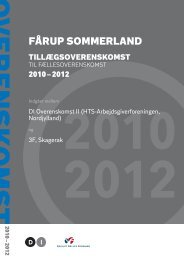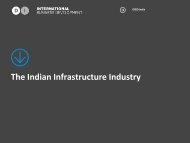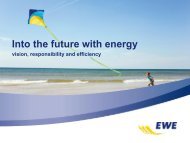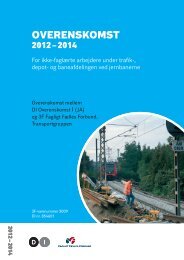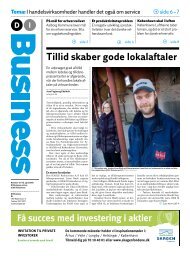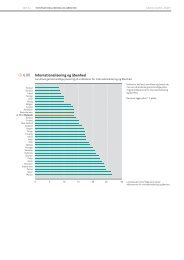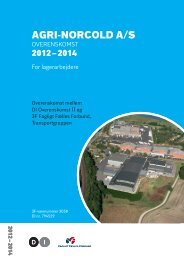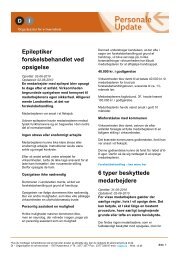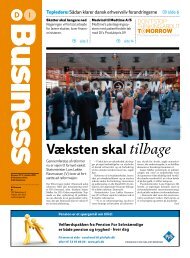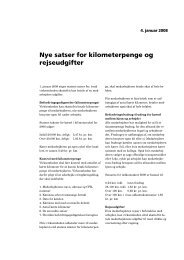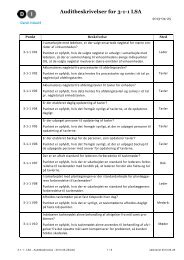Hydrogen and its competitors, 2004
Hydrogen and its competitors, 2004
Hydrogen and its competitors, 2004
Create successful ePaper yourself
Turn your PDF publications into a flip-book with our unique Google optimized e-Paper software.
18Risø Energy Report 3<strong>Hydrogen</strong> in the Danish energy system42001 the programme was cancelled. Its goal was to studythe use of hydrogen in a future Danish sustainableenergy system. Priority was given to pre-competitiveresearch <strong>and</strong> demonstration projects in hydrogen technologies,<strong>and</strong> the development <strong>and</strong> application of PEMfuel cells for stationary <strong>and</strong> mobile applications. The programmesupported 14 projects with a total budget of€4.8 million. The abrupt cancellation of the projectcaused temporary set back in R&D activities amongapplicants, especially small <strong>and</strong> medium sized technologyproviders.Over the years the National Energy Research Programmehas given priority to R&D in SOFCs. In the period 1998-2002 it supported 12 projects with a total budget of€10.95 million, which is more than half the total spenton Danish R&D in hydrogen <strong>and</strong> fuel cells. Other projectson hydrogen storage <strong>and</strong> networks have also beensupported through the National Energy Research Programme<strong>and</strong> the Public Service Obligation funds.In 2002 the Research Councils launched an initiative tosupport centres of excellence, with the aim of promotingresearch across institutional <strong>and</strong> disciplinary boundaries.A centre of excellence entitled “Towards a <strong>Hydrogen</strong>Based Society” was among the first of these institutionsto be founded, with a budget of €3 million. Towards a<strong>Hydrogen</strong> Based Society deals with R&D in catalysis <strong>and</strong>hydrogen storage, plus small demonstration projects. Ithas a strong focus on fundamental research, <strong>and</strong> representsan important opportunity to boost basic researchin Denmark. At the same time it is promoting collaborationbetween basic <strong>and</strong> applied science groups, includingDanish industry.Danish involvement in international researchDanish researchers are well represented in European fuelcell R&D. In the period 1999-2002, Danish partners wererepresented in 9 out of 43 fuel cell projects supported bythe European Commission's Fifth Framework Programme(FP5) on Energy, Environment <strong>and</strong> SustainableDevelopment (EESP), <strong>and</strong> in many other EU projects(Table 2).In the Sixth Framework Programme (FP6), Danish partnersare represented in four out of ten projects onhydrogen <strong>and</strong> six on fuel cells, including the projectsHySafe, Real-SOFC, Naturalhy <strong>and</strong> FURIM.Competitiveness of Danish researchThe competitiveness of Danish research in hydrogen <strong>and</strong>fuel cells can be measured in different ways. We can lookat both the “internal” quality of research (measuredthrough the so-called Merton values, which relate toscientific excellence, public good, universality etc.), <strong>and</strong>the “external” quality (relevance to society <strong>and</strong> wealthcreation) [6]. No single approach to measuring researchquality is the correct one; instead we need to takeaccount of as many factors as possible, <strong>and</strong> try to underst<strong>and</strong>the links between science <strong>and</strong> economic activities[1].Citations are often used as an indicator of scientificquality [5]. Although this approach has many pitfalls,citation studies at national level give good insights intothe relative positions of nations in specific technologyareas.The success of emerging hydrogen energy technologiesdepends strongly on the scientific quality of the research,but also on the availability of development know-how<strong>and</strong> the investment needed to bring new ideas on themarket. One way to measure the practical application ofR&D is to study patent applications.An application for a patent indicates the existence ofTable 2: Overview of EU FP5 <strong>and</strong> other projects with Danish partners.Fifth Framework Programme (EESP) projectsOther EU projectsScale-up of the IP-SOFC to multi-tens of kW Level (MF-SOFC) (Risø)Component reliability in SOFC Systems for Commercial Operation (CORE-SOFC) (Risø, HaldorTopsøe A/S)Pressurized IP-SOFC (PIP-SOFC) (Risø)Integrated Researches on Materials, Technologies <strong>and</strong> Processes to Enhance MCFC (Rich Müller)50 kW PEM fuel cell generator for CHP <strong>and</strong> UPS applications (50PEM-HEAP) (IRD Fuel Cells A/S)High-temperature PEMFC Stack with Methanol Reforming (AMFC) (Technical University ofDenmark)Development of Low-cost, High-efficient PEMFC (APOLLON) (Technical University of Denmark)A 1kW DMFC Portable Power Generator (PORTAPOWER) (IRD Fuel Cells A/S)Thematic network on SOFC Technology (SOFCnet) (Risø)Advanced solid polymer fuel cells foroperation at temperatures up to200°C (Technical University ofDenmark)Ammonia Cracking (Risø)Synthesis, fabrication <strong>and</strong> characterisationof alternative anodes fordirect methane oxidation in SOFC(Risø)Advanced prediction, monitoring<strong>and</strong> controlling of anaerobic digestionprocesses behaviour towardsbiogas usage in fuel cells (Gascon)



